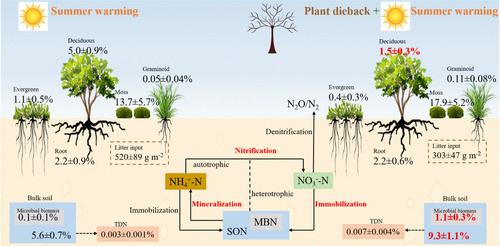当前位置:
X-MOL 学术
›
Glob. Change Biol.
›
论文详情
Our official English website, www.x-mol.net, welcomes your
feedback! (Note: you will need to create a separate account there.)
Arctic Tundra Plant Dieback Can Alter Surface N2O Fluxes and Interact With Summer Warming to Increase Soil Nitrogen Retention
Global Change Biology ( IF 10.8 ) Pub Date : 2024-10-25 , DOI: 10.1111/gcb.17549 Wenyi Xu, Bo Elberling, Dan Li, Per Lennart Ambus
Global Change Biology ( IF 10.8 ) Pub Date : 2024-10-25 , DOI: 10.1111/gcb.17549 Wenyi Xu, Bo Elberling, Dan Li, Per Lennart Ambus

|
In recent years, the arctic tundra has been subject to more frequent stochastic biotic or extreme weather events (causing plant dieback) and warmer summer air temperatures. However, the combined effects of these perturbations on the tundra ecosystem remain uninvestigated. We experimentally simulated plant dieback by cutting vegetation and increased summer air temperatures (ca. +2°C) by using open‐top chambers (OTCs) in an arctic heath tundra, West Greenland. We quantified surface greenhouse gas fluxes, measured soil gross N transformation rates, and investigated all ecosystem compartments (plants, soils, microbial biomass) to utilize or retain nitrogen (N) upon application of stable N‐15 isotope tracer. Measurements from three growing seasons showed an immediate increase in surface CH4 and N2 O uptake after the plant dieback. With time, surface N2 O fluxes alternated between emission and uptake, and rates in both directions were occasionally affected, which was primarily driven by soil temperatures and soil moisture conditions. Four years after plant dieback, deciduous shrubs recovered their biomass but retained significantly lower amounts of 15 N, suggesting the reduced capacity of deciduous shrubs to utilize and retain N. Among four plant functional groups, summer warming only increased the biomass of deciduous shrubs and their 15 N retention, while following plant dieback deciduous shrubs showed no response to warming. This suggests that deciduous shrubs may not always benefit from climate warming over other functional groups when considering plant dieback events. Soil gross N mineralization (~ −50%) and nitrification rates (~ −70%) significantly decreased under both ambient and warmed conditions, while only under warmed conditions immobilization of NO3 − significantly increased (~ +1900%). This explains that plant dieback enhanced N retention in microbial biomass and thus bulk soils under warmed conditions. This study underscores the need to consider plant dieback events alongside summer warming to better predict future ecosystem‐climate feedback.
中文翻译:

北极苔原植物枯死可以改变表面的 N2O 通量,并与夏季变暖相互作用,以增加土壤氮保持率
近年来,北极苔原受到更频繁的随机生物或极端天气事件(导致植物枯死)和温暖的夏季气温的影响。然而,这些扰动对苔原生态系统的综合影响仍未得到研究。我们在西格陵兰岛的北极荒地苔原上使用开顶室 (OTC) 通过砍伐植被和提高夏季气温 (约 +2°C) 来实验模拟植物枯死。我们量化了地表温室气体通量,测量了土壤总氮转化率,并研究了所有生态系统区室(植物、土壤、微生物生物量)在应用稳定的 N-15 同位素示踪剂后利用或保留氮 (N)。三个生长季节的测量表明,植物枯死后表面 CH4 和 N2O 吸收立即增加。随着时间的推移,表面 N2O 通量在发射和吸收之间交替,两个方向的通量偶尔会受到影响,这主要是由土壤温度和土壤水分条件驱动的。植物枯死四年后,落叶灌木恢复了其生物量,但保留了显着较低的 15 氮,这表明落叶灌木利用和保留氮的能力降低。在 4 个植物功能群中,夏季变暖仅增加了落叶灌木的生物量及其 15N 保留,而植物枯萎的落叶灌木对变暖没有反应。这表明,在考虑植物枯死事件时,落叶灌木可能并不总是受益于气候变暖,而不是其他功能组。 土壤总氮矿化 (~ −50%) 和硝化速率 (~ −70%) 在环境和温暖条件下均显著降低,而仅在温暖条件下,NO3− 的固定化显著增加 (~ +1900%)。这解释了植物枯死增强了微生物生物量中的氮保留,从而在温暖条件下增强了散装土壤。这项研究强调需要将植物枯萎事件与夏季变暖一起考虑,以更好地预测未来的生态系统-气候反馈。
更新日期:2024-10-25
中文翻译:

北极苔原植物枯死可以改变表面的 N2O 通量,并与夏季变暖相互作用,以增加土壤氮保持率
近年来,北极苔原受到更频繁的随机生物或极端天气事件(导致植物枯死)和温暖的夏季气温的影响。然而,这些扰动对苔原生态系统的综合影响仍未得到研究。我们在西格陵兰岛的北极荒地苔原上使用开顶室 (OTC) 通过砍伐植被和提高夏季气温 (约 +2°C) 来实验模拟植物枯死。我们量化了地表温室气体通量,测量了土壤总氮转化率,并研究了所有生态系统区室(植物、土壤、微生物生物量)在应用稳定的 N-15 同位素示踪剂后利用或保留氮 (N)。三个生长季节的测量表明,植物枯死后表面 CH4 和 N2O 吸收立即增加。随着时间的推移,表面 N2O 通量在发射和吸收之间交替,两个方向的通量偶尔会受到影响,这主要是由土壤温度和土壤水分条件驱动的。植物枯死四年后,落叶灌木恢复了其生物量,但保留了显着较低的 15 氮,这表明落叶灌木利用和保留氮的能力降低。在 4 个植物功能群中,夏季变暖仅增加了落叶灌木的生物量及其 15N 保留,而植物枯萎的落叶灌木对变暖没有反应。这表明,在考虑植物枯死事件时,落叶灌木可能并不总是受益于气候变暖,而不是其他功能组。 土壤总氮矿化 (~ −50%) 和硝化速率 (~ −70%) 在环境和温暖条件下均显著降低,而仅在温暖条件下,NO3− 的固定化显著增加 (~ +1900%)。这解释了植物枯死增强了微生物生物量中的氮保留,从而在温暖条件下增强了散装土壤。这项研究强调需要将植物枯萎事件与夏季变暖一起考虑,以更好地预测未来的生态系统-气候反馈。


















































 京公网安备 11010802027423号
京公网安备 11010802027423号